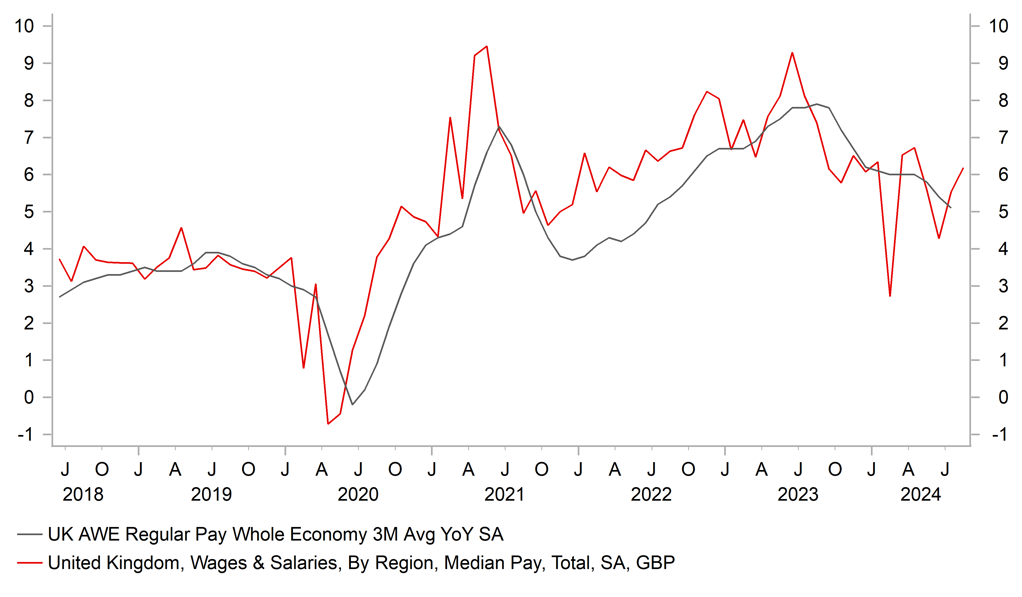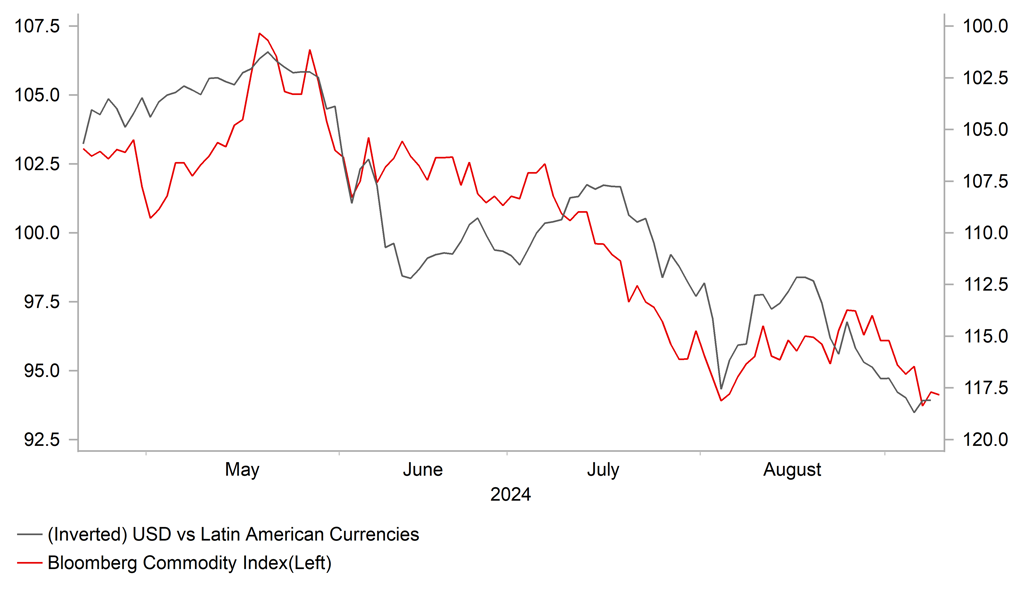USD is holding on to gains ahead of US presidential debate
GBP/USD: BoE is expected to cut rates more slowly than the Fed
The modest rebound for the US dollar since the end of last week has resulted in cable falling back closer to the 1.3000-level as it moves further below the high from 27th August at 1.3266. The US dollar is continuing to derive more support at the start of this week from the scaling back of expectations for a larger 50bps Fed rate cut as soon as next week. Nevertheless the US rate market is still pricing in around 110bps of Fed cuts by the end of this year and around 225bps of cuts by the summer of next year. The pricing highlights that market participants are still expecting the Fed to cut rates aggressively in the year ahead in anticipation that the US labour market will continue to weaken and inflation will slow back towards the Fed’s target. The next key test of the dovish outlook for Fed policy will be provided by the release tomorrow of the latest US CPI report for August. The softer inflation readings over the previous four months have supported expectations for Fed rate cuts. The last time there was a significant upside inflation surprise was back in April when the March inflation data was released.
Recent communication from Fed officials has indicated that they are starting to place more emphasis on labour market conditions when setting monetary policy as well. However, it will still be important for the incoming US inflation data to remain consistent with slowing inflation to back up current market expectations for aggressive Fed rate cuts. While one month of stronger inflation data in August would not stop the Fed from cutting rates next week, it would cast further doubt on the aggressive scale of easing currently priced in and pose upside risks for the US dollar. The other focus for the US dollar this evening will be the first presidential debate between Kamala Harris and Donald Trump. Ahead of the debate it has been reported that Kamala Harris has lost some upward momentum in recent opinion polls. The race to become the next presidential appears finely balanced which could contribute to bigger market reaction if there are any decisive moments in the debate.
In contrast to the Fed, the UK rate market is pricing in a less aggressive easing cycle from the BoE in the year ahead. There are currently around 50bps of BoE rate cuts priced by he end of this year and between 125-150bps of cuts by next summer. The next BoE rate cut is not expected until the November MPC meeting following the finely balanced decision to begin cutting rates last month. The release this morning of the latest UK labour market report is unlikely to encourage market expectations for an earlier BoE rate cut as soon as next week. The report revealed that employment growth increased more strongly than expected by 265k 3M/3M in July. It was the strongest equivalent reading since May 2022 and provide evidence that the stronger growth in the 1H of this year is starting to feed through to some improvement in the labour market as well. The BoE will be pleased though that there was also further evidence of softening wage growth. Regular average weekly earnings slowed to an annual rate of 5.1% in July which was the lowest reading since June 2022. Th median pay measure of wage growth was less encouraging pricing up to an annual rate of 6.2% in August. We still expect the BoE to cut rates again in November but today’s labour market report highlights that it is not a done deal, and could encourage a stronger pound in the near-term.
WAGE GROWTH SLOWING IN UK BUT REMAINS ELEVATED

Source: Bloomberg, Macrobond & MUFG GMR
EM FX: Fed rate cuts not sufficient for broad-based EM FX rebound
Emerging market currencies have weakened modestly against the USD over the past week. The worst performing emerging market currencies have been the RUB (-4.4% vs. USD), CLP (-1.6%), COP (-1.4%), HUF (-0.8%) and PEN (-0.6%). In contrast, the THB (+1.1% vs. USD), BRL (+1.1%), and ZAR (+0.8%) have outperformed. Within emerging market currencies, there has been a clear divergence in performance between Asian and Latam currencies over the summer. Asian currencies have rebounded while Latam currencies have continued to weaken.
Asian currencies have benefitted the most from building expectations for more aggressive Fed easing. The best performing emerging market currencies over the last couple of months have been the MYR (+7.9% vs. USD) and THB (+7.5%). While Latam currencies have been undermined in part by ongoing weakness in commodity prices alongside idiosyncratic domestic concerns. Bloomberg’s commodity price index fell to a fresh year to date low at the end of last week which saw the price of oil drop back towards USD70/barrel. In response OPEC+ members delayed plans to increase oil production by two months. Commodity price weakness has coincided with further evidence of slowing growth momentum in China. Those growth concerns haven been reinforced by further evidence of weak inflation pressures in China. Those developments are creating a headwind for commodity-related emerging market currencies heading into year end. Please see our latest EM EMEA Weekly (click here) for more details.
LATAM FX UNDERMINED IN PART BY FALLING COMMODITY PRICES

Source: Bloomberg, Macrobond & MUFG GMR
KEY RELEASES AND EVENTS
|
Country |
GMT |
Indicator/Event |
Period |
Consensus |
Previous |
Mkt Moving |
|
IT |
09:00 |
Industrial Production MoM |
Jul |
-0.2% |
0.5% |
!! |
|
US |
11:00 |
NFIB Small Business Optimism |
Aug |
93.6 |
93.7 |
!! |
|
NZ |
22:05 |
RBNZ Assistant Governor Karen Silk Speaks |
!! |
|||
|
NZ |
23:45 |
Net Migration SA |
Jul |
-- |
2,710 |
! |
Source: Bloomberg
